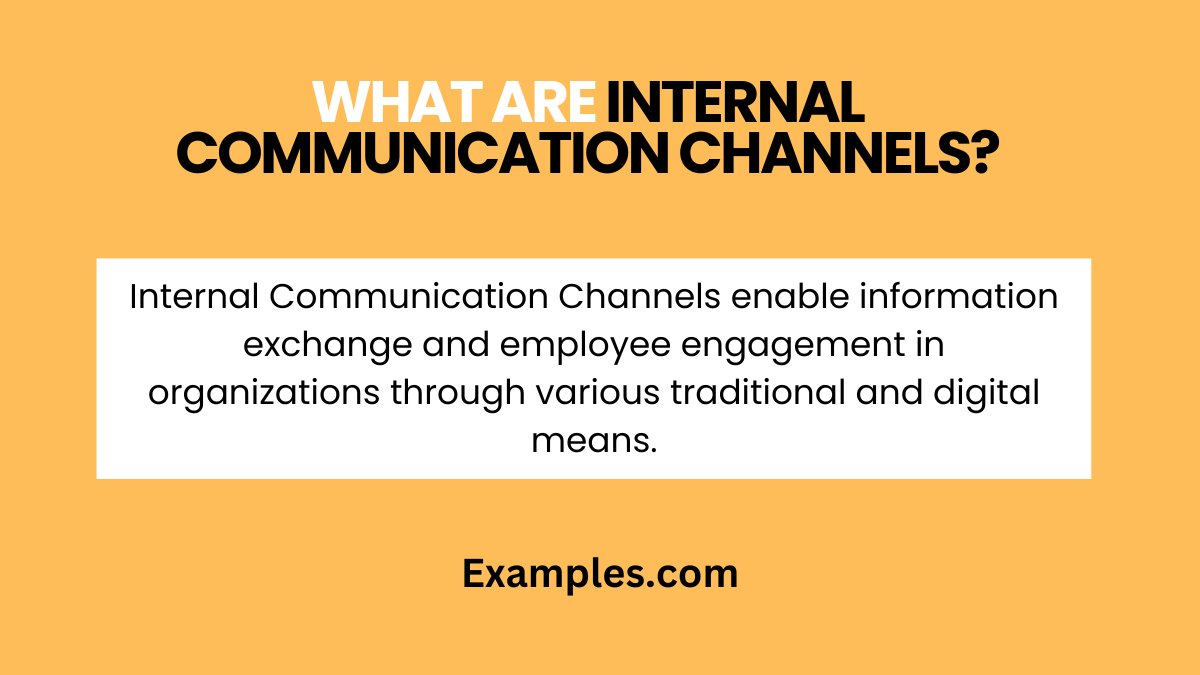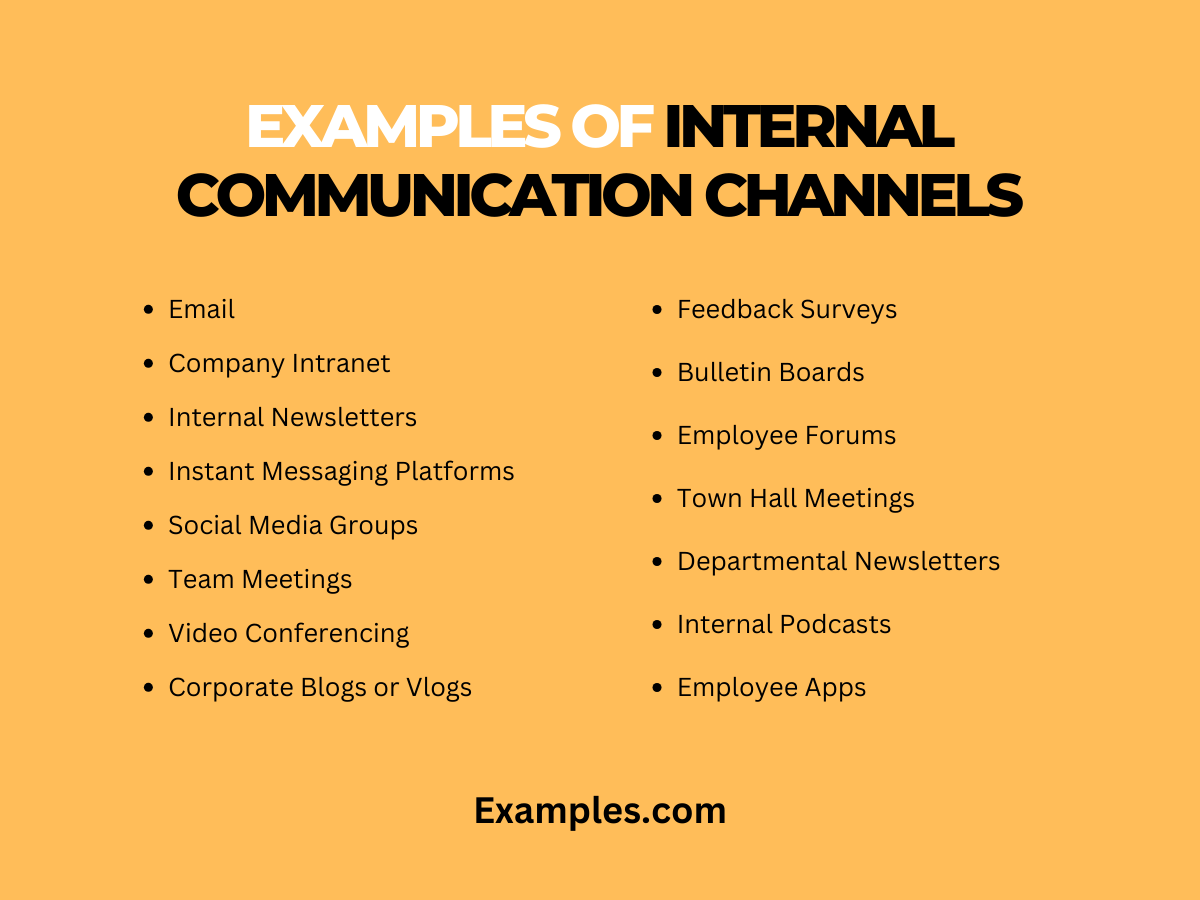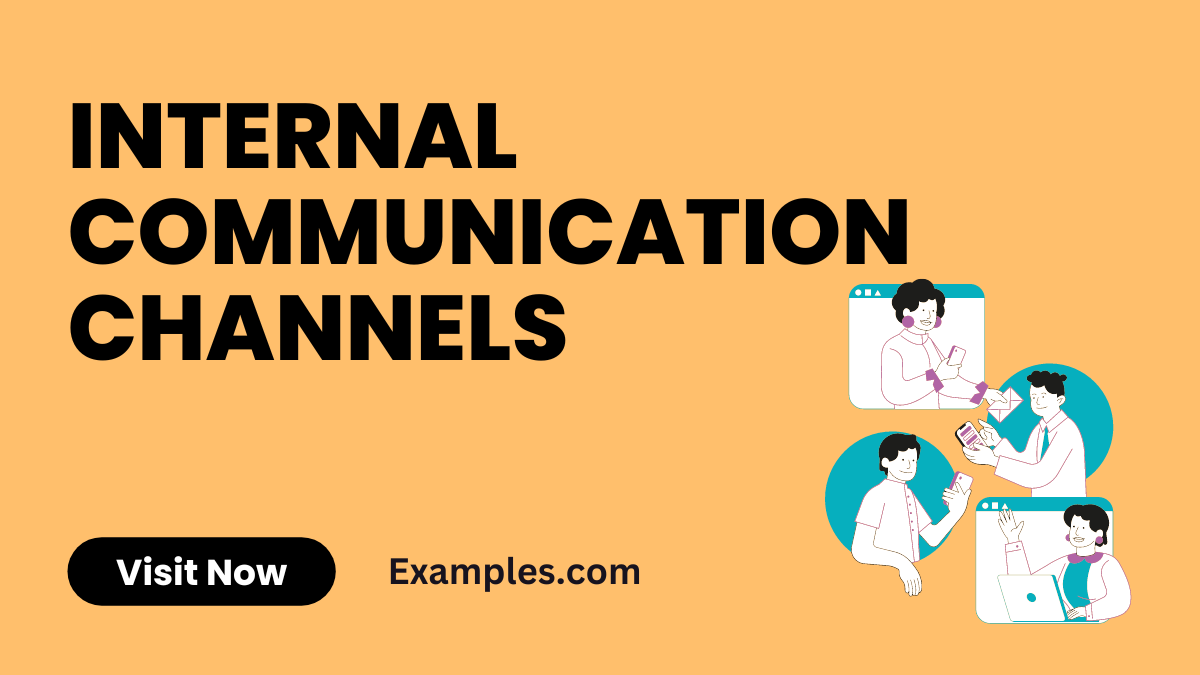14+ Internal Communication Channels Examples
In the dynamic world of organizational communication, mastering Internal Communication Channels is key to fostering an effective and cohesive work environment. This guide delves deep into the array of channels available for internal communication, each serving unique purposes in facilitating information flow and employee engagement. From traditional face-to-face meetings to cutting-edge digital platforms, we explore how these channels can be optimized to enhance team collaboration, streamline processes, and boost overall productivity. Understanding and leveraging these internal communication channels is crucial for any organization seeking to maintain a connected, informed, and responsive workforce.
What are Internal Communication Channels?

Internal Communication Channels are the various methods and tools used by an organization to share information, ideas, and feedback among its employees and management. These channels are fundamental to ensuring that all members of an organization are aligned, informed, and engaged. They range from traditional face-to-face interactions, such as meetings and one-on-one conversations, to digital means like emails, intranets, and social media platforms. Effectively utilizing these channels is crucial for maintaining smooth internal operations and fostering a positive workplace culture.
15 Internal Communication Channels

In the ever-evolving landscape of corporate communication, understanding and utilizing various Internal Communication Channels is crucial for organizational success. This guide offers an insightful look into 15 distinct channels, each serving a unique purpose in facilitating effective internal dialogue. From traditional methods to innovative digital platforms, these examples demonstrate how diverse communication channels can be leveraged to enhance information dissemination, employee engagement, and overall workplace harmony.
- Email: A staple in corporate communication for formal and informative messages.
- Example: “Please refer to the email sent for details on the new health insurance policy.”
- Company Intranet: A central hub for company news, resources, and documents.
- Example: “You can find the latest project guidelines and templates on our intranet.”
- Internal Newsletters: Regular updates on company events, achievements, and news.
- Example: “Our monthly newsletter includes a summary of key company achievements and upcoming events.”
- Instant Messaging Platforms: Tools like Slack or Microsoft Teams for quick, informal communication.
- Example: “Please share the meeting notes in our team’s Slack channel.”
- Social Media Groups: Private groups on platforms like Facebook or LinkedIn for informal interaction and updates.
- Example: “Join our Facebook group for more casual updates and team-building activities.”
- Team Meetings: Regular scheduled meetings for updates, feedback, and team alignment.
- Example: “In our weekly team meeting, we’ll discuss the project’s progress and any roadblocks.”
- Video Conferencing: Tools like Zoom or Skype, essential for connecting remote teams.
- Example: “We’ll be having a Zoom call next Wednesday to finalize our strategy.”
- Corporate Blogs or Vlogs: Platforms for sharing insights, stories, or updates in a more personal format.
- Example: “Check out our latest vlog from the CEO on our corporate blog.”
- Feedback Surveys: Online surveys to gather employee feedback and insights.
- Example: “Please complete the internal survey to provide your feedback on workplace improvements.”
- Bulletin Boards: Physical or digital boards for posting important notices and information.
- Example: “Notice about the upcoming office renovation is posted on the bulletin board.”
- Employee Forums: Online platforms for employees to discuss ideas and issues.
- Example: “Use our employee forum to share your ideas on improving workplace sustainability.”
- Town Hall Meetings: Large, organization-wide meetings for major announcements or Q&A sessions.
- Example: “Our annual town hall meeting will address major organizational changes.”
- Departmental Newsletters: Newsletters focused on specific departmental news and updates.
- Example: “The IT department’s newsletter has updates on the new software implementation.”
- Internal Podcasts: Audio content focusing on company news, interviews, or educational material.
- Example: “Listen to our monthly podcast for insights from various team leaders.”
- Employee Apps: Custom mobile applications for news, schedules, and employee resources.
- Example: “Download our employee app for quick access to your work schedule and HR resources.”
Internal Communication Channels for Employees
Choosing the right Internal Communication Channels for employees is essential for fostering effective workplace communication. These channels not only facilitate the flow of information but also enhance employee engagement and collaboration.
- Email Communication: A traditional yet vital channel, emails are ideal for formal announcements, policy updates, and detailed information sharing. They offer a record of communication and are efficient for reaching all employees.
- Instant Messaging and Chat Apps: Platforms like Slack or Microsoft Teams enable real-time, informal communication among employees. These tools are excellent for quick queries, team collaborations, and creating a more connected workforce.
- Internal Social Networks: Social platforms specifically designed for workplace interaction, like Yammer or Workplace from Facebook, encourage informal networking and sharing among employees, strengthening interpersonal communication.
- Intranet Portals: A centralized repository for all corporate information, documents, and resources. An effective intranet supports a wide range of internal communication needs, from HR documents to project collaboration spaces.
- Video Conferencing Tools: With the rise of remote work, tools like Zoom and Skype have become indispensable for maintaining effective communication across distances, enabling face-to-face interactions digitally.
The Most Relevant Internal Communication Channels
The relevance of Internal Communication Channels can vary based on the organization’s size, culture, and objectives. However, certain channels have proven universally effective.
- Company-wide Meetings (Town Halls): These are essential for disseminating key organizational changes and achievements, fostering a sense of unity and openness across the organization.
- Employee Feedback Tools: Channels like surveys or suggestion boxes are crucial for gathering employee feedback, an integral part of a communication strategy focused on continuous improvement.
- Digital Notice Boards: Digital versions of traditional bulletin boards can be highly effective for displaying important notices, updates, and even celebrating employee milestones.
- Mobile Communication Apps: Custom mobile apps tailored for internal communication are becoming increasingly relevant, providing employees with easy access to information and resources on-the-go.
- Newsletters: Regular internal newsletters can effectively summarize key information, keeping employees updated on various organizational aspects without overwhelming them with daily communications.
What are the Channels of Internal Communication within an Organization?
Understanding the different channels of internal communication within an organization is key to implementing an effective communication strategy.
- Face-to-Face Meetings: Despite the rise of digital tools, face-to-face meetings remain a crucial channel for in-depth discussions, brainstorming sessions, and building personal connections.
- Emails and Memos: For formal and official communication, emails and memos are still widely used. They are effective for communicating detailed and recordable information.
- Collaboration Platforms: Tools like Asana, Trello, or Microsoft Teams facilitate project management and team collaboration, essential in today’s dynamic work environments.
- Internal Podcasts or Webinars: These are innovative channels for engaging employees in ongoing learning and development, sharing insights, or discussing company news in an engaging format.
- Employee Engagement Platforms: Platforms dedicated to employee recognition and engagement can play a significant role in boosting morale and fostering a positive company culture.
In conclusion, effective internal communication channels are vital for any organization’s success. By choosing the right channels and implementing strategic communication practices, businesses can enhance collaboration, streamline information flow, and align goals. Our guide provides practical examples and tips to help you establish robust communication channels, ensuring a cohesive and well-informed workforce that drives organizational growth and success.



